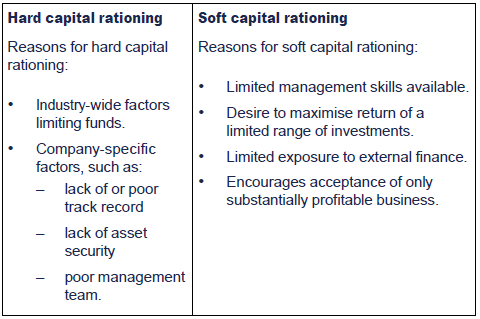Capital rationing
Financial managers have maximising shareholder wealth as their main objective.
Shareholder wealth is maximised if a company undertakes all possible positive NPV projects.
Capital rationing is where there are insufficient funds to do so. This implies that where investment capital is rationed, shareholder wealth is not being maximised.
Types of capital rationing
Hard capital rationing
An absolute limit on the amount of finance available is imposed by the lending institutions.
Soft capital rationing
A company may impose its own rationing on capital. This is contrary to the rational view of shareholder wealth maximisation.
Reasons for capital rationing

Single and multi-period capital rationing
Capital rationing can apply to a single period, or to multiple periods. Single-period capital rationing occurs when there is a shortage of funds for one period only. Multi-period capital rationing is where there will be a shortage of funds in more than one period.
Dealing with single-period capital rationing
Divisible projects
Where potential projects are able to be divided, ie any fraction of the project may be undertaken and the returns from the project are expected to be generated in exact proportion to the amount of investment undertaken, a calculation known as the profitability index (PI) is used. This a variation on key factor analysis and the aim when managing capital rationing is to maximise the NPV earned per $1 invested in projects.
This is done by:
(1)calculating a PI for each project (see below)
(2)ranking the projects according to their PI
(3)allocating funds according to the projects’ rankings until they are used up.
The formula is:
Indivisible projects
If projects are indivisible it must be done in its entirety or not at all. To determine the optimum use of capital investment, a trial and error approach must be used.
Mutually-exclusive projects
Sometimes the taking on of projects will preclude the taking on of another, e.g. they may both require use of the same asset.
In these circumstances, each combination of investments is tried to identify which earns the higher level of returns.
Dealing with multi-period capital rationing
Linear programming
A solution to a multi-period capital rationing problem cannot be found using PIs. This method can only deal with one limiting factor(i.e. one period of shortage). Here there are a number of limiting factors (i.e. a number of periods of shortage) and linear programming techniques must therefore be applied.
Objective functions
The linear programming method can be applied to a multi-period capital rationing problem in one of two ways. The objective of the solution can be either:
- to maximise the total NPV from the investment in available projects
- to maximise the present value of cash flow available for dividends.
Both techniques result in the same project selections.
Dual values
The dual price is:
- the amount by which one additional unit of scarce resource would increase the value of the objective function, or alternatively
- the amount by which one fewer unit of scarce resource would decrease the value of the objective function.
In capital rationing, the scarce resource is available funds, so the dual value expresses the increase in the objective function gained if one more dollar became available, or the reduction if one less dollar were invested.
The amount of the dual value varies depending on which method is used to formulate the linear programme:
- NPV method - the dual equals the change in NPV earned if $1 more or less is available.
- PV of dividends method - the dual equals the change in the PV of cash available to pay dividends if $1 more or less is available.
|
Created at 9/5/2012 3:02 PM by System Account
(GMT) Greenwich Mean Time : Dublin, Edinburgh, Lisbon, London
|
Last modified at 11/1/2016 3:50 PM by System Account
(GMT) Greenwich Mean Time : Dublin, Edinburgh, Lisbon, London
|
|
|
|
 |
Rating
:
|
 Ratings & Comments
(Click the stars to rate the page) Ratings & Comments
(Click the stars to rate the page)
|
 |
Tags:
|
|
|
|
|